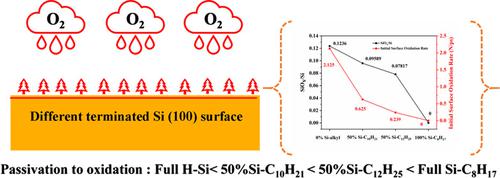当前位置:
X-MOL 学术
›
Chin. J. Chem.
›
论文详情
Our official English website, www.x-mol.net, welcomes your feedback! (Note: you will need to create a separate account there.)
Atomistic Insights into Oxidation of Chemical Passivated Silicon (100) Surface: Reactive Molecular Dynamic Simulations
Chinese Journal of Chemistry ( IF 5.4 ) Pub Date : 2020-11-17 , DOI: 10.1002/cjoc.202000476 Shideng Yuan 1 , Xueyu Wang 1 , Heng Zhang 1 , Shiling Yuan 1
Chinese Journal of Chemistry ( IF 5.4 ) Pub Date : 2020-11-17 , DOI: 10.1002/cjoc.202000476 Shideng Yuan 1 , Xueyu Wang 1 , Heng Zhang 1 , Shiling Yuan 1
Affiliation

|
In this paper, a series of ReaxFF molecular dynamic simulations were performed to study the oxidation of chemical passivated silicon (100) surface, which was terminated with different n‐alkyl chains. The simulated results showed that the oxidant species diffuse into Si substrate through peroxy‐like structures during the oxidation process. During the oxidation process, the Si‐alkyl (Si—C) covalent bond was stable and there is no occurrence of decomposition of the n‐alkyl chains. In addition, the existence of n‐alkyl monolayers on silicon surface did not change the initial reaction pathway of the oxidation process. The simulations indicated that the chemical passivation mechanism includes two parts, one is about the Si—C covalent bond occupying the active site of the reaction on Si (100) surface, and the other is about the oxygen penetrating Si‐alkyl layers. The simulations also indicated that the chemical passivation of Si‐alkyl is better for longer alkyl chains, which is consistent with the experimental observation. Our results have investigated the oxidation of chemical passivated silicon (100) surface at the atom level, which is helpful to comprehend the manufacture of semiconductor devices like metal‐oxide‐semiconductor (MOS) devices in the experiments.
中文翻译:

化学钝化硅(100)表面氧化的原子学见解:反应性分子动力学模拟
在本文中,进行了一系列ReaxFF分子动力学模拟,以研究化学钝化硅(100)表面的氧化,该表面被不同的正烷基链终止。模拟结果表明,在氧化过程中,氧化剂通过过氧样结构扩散到硅衬底中。在氧化过程中,Si-烷基(Si-C)共价键是稳定的,并且不发生n-烷基链的分解。另外,n的存在硅表面上的烷基单分子层并未改变氧化过程的初始反应路径。模拟表明,化学钝化机理包括两部分,一个是关于Si-C共价键占据反应在Si(100)表面上的活性位点,另一个是关于氧渗透的Si-烷基层。模拟还表明,对于更长的烷基链,Si-烷基的化学钝化效果更好,这与实验观察结果一致。我们的结果研究了化学钝化硅(100)表面在原子水平上的氧化,这有助于在实验中理解诸如金属氧化物半导体(MOS)器件之类的半导体器件的制造。
更新日期:2020-11-17

中文翻译:

化学钝化硅(100)表面氧化的原子学见解:反应性分子动力学模拟
在本文中,进行了一系列ReaxFF分子动力学模拟,以研究化学钝化硅(100)表面的氧化,该表面被不同的正烷基链终止。模拟结果表明,在氧化过程中,氧化剂通过过氧样结构扩散到硅衬底中。在氧化过程中,Si-烷基(Si-C)共价键是稳定的,并且不发生n-烷基链的分解。另外,n的存在硅表面上的烷基单分子层并未改变氧化过程的初始反应路径。模拟表明,化学钝化机理包括两部分,一个是关于Si-C共价键占据反应在Si(100)表面上的活性位点,另一个是关于氧渗透的Si-烷基层。模拟还表明,对于更长的烷基链,Si-烷基的化学钝化效果更好,这与实验观察结果一致。我们的结果研究了化学钝化硅(100)表面在原子水平上的氧化,这有助于在实验中理解诸如金属氧化物半导体(MOS)器件之类的半导体器件的制造。




























 京公网安备 11010802027423号
京公网安备 11010802027423号